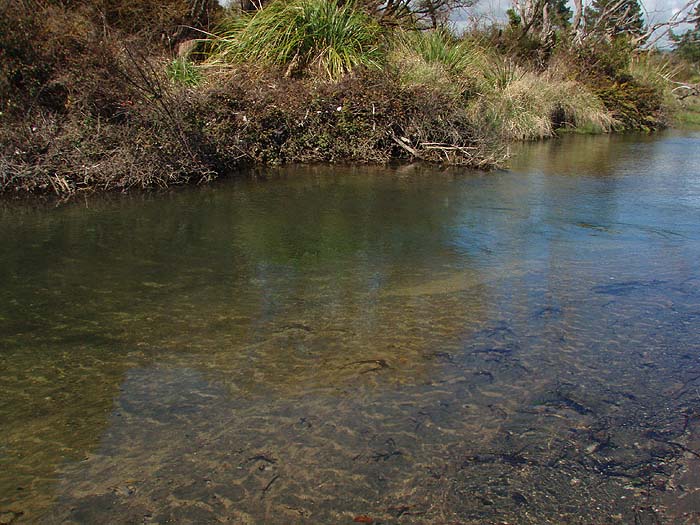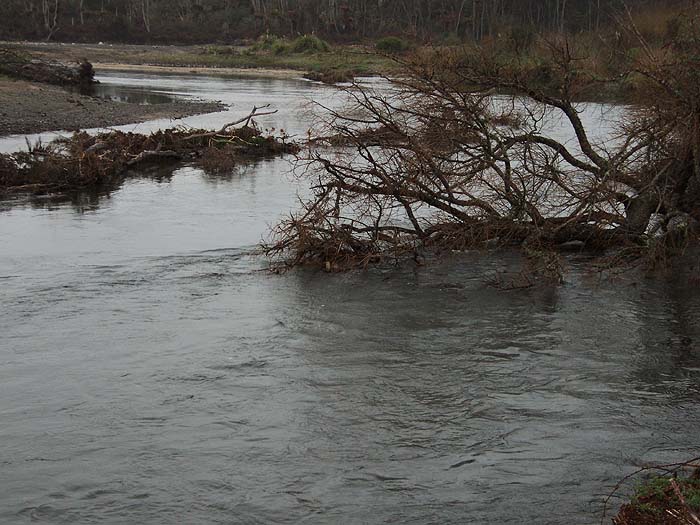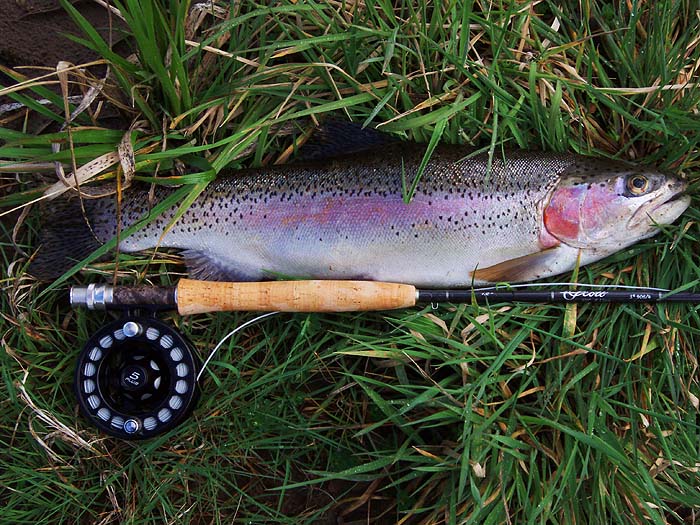
Information Page.
The grass on the other side may not be greener.
04 Sept 2009
My pal Alan has been trout fishing in New Zealand. Now I suppose everyone knows that NZ is famous for its monster trout but Alan's experiences show that the grass is not always greener on the other side of the World. It cheers me up a bit to know that other people sometimes struggle a bit anyway. Here's his accounts of the trip especially for the game anglers among you.
Hi Mike,
Fishing at Turangi was exasperatingly difficult. One fish in 3 days and I caught it on cast #4 of the trip. Nothing else for 4897 casts (or so it seemed). Lost lots of flies. No chance to add nylon guards or tie upside down as only fishing size 10, 12, 14 flies. Unseasonably warm at Turangi and Sandy even got sunburned hands. Hot sun in August, how bizarre! Bloody fish even started rising to Mayflies on Sunday...but I’d left all my dry flies at home. Didn’t I tell you before I went that I was going to do that?
I made a very silly mistake and it basically cost me two days fishing. I forgot to change from an Airflo floating tapered trace (used in summer when fishing dry flies – cicadas) to straight nylon or fluorocarbon and consequently my tungsten bead headed nymphs were not getting down deep enough at the head of the deep lies. In essence the floating tapered leader worked against the weighted nymphs and slowed their descent through the water column. I realised on Sunday what the problem was and switched to a sinking polyleader only to lose it on a snag within the first 10 casts.
Overall though it was very therapeutic and I really enjoyed being on the river again. Our problem was that there were a lot of anglers on the river by the time Sandy and I dawdled down at 9.30 am after a leisurely breakfast. Every run had been thrashed and there were anglers anchored in all the best lies. It is no coincidence that my fish came from a backwater that had been ignored by the masses. It was a resident non-spawner that was actively feeding on caddis in a small eddy. I’ll write you a story and send some photographs later this week.
Many thanks and very best regards,
Alan Bulmer
Alan, as promised, followed up with a full account of his trip. As always it was a good read so 'yer tiz!.
Hi Mike,
As you know, Sandy & I arranged to go down to Turangi last weekend to fish the Tauranga-Taupo. Rather than face a 4 hour drive each way, we opted to cash in some Air Points to fly to Taupo and collect a rental car for the short drive to Turangi. What a revelation! We left Auckland at 7.55 am and were relaxing in a cafe in Turangi sipping a piping hot latte by 9.30 am. Next stop was the Tauranga-Taupo River for a fish. By now it was about 11.00 am and there were already 5 vehicles in the car park. We opted to start fishing where we’d had some much fun casting cicadas over the summer and as luck would have it no-one was fishing the first run we stumbled upon. The river was running high with a hint of milky colour which was ideal for upstream nymphing with a pair of tungsten beaded nymphs. The increased flow had suspended some coarse silt and small pumice granules and these tended to gather wherever the flow eddied. Linking arms we gingerly crossed the river at the tail of the run and made our way upstream.
The river bank was awash with boot prints so leaving Sandy to tackle up I opted to explore a nearby backwater. Here there was no sign of fishing activity. I lobbed the nymphs high in the run and allowed them to sink and plumb the depths of the first, and largest, hole. Nothing doing as the flies were riding too high in the water column. I had a couple more casts through the run and still was unable to get the depth required to elicit a strike. At this point I noticed a smaller hole above the one that I was fishing. In the summer it had not been deep enough to hold fish but now it looked very likely.
I carefully backed away from the bank I was on and crossed a side branch to get into a downstream position to fish this new hole. Before casting I checked that all was well with the Pheasant Tail nymph (Copper bead thorax) and Bloody Butcher fly before sending a short cast into the far side of the eye of the pool. (see photograph of the Honey hole – casting to right hand side of the image). The flies plopped in quietly and sunk quickly through the less turbulent water. Suddenly the tip of the fly line jerked out from the bank and I instinctively struck to come up solid on a trout. I yelled out to Sandy that I was in, just as the fish showed itself. It was writhing angrily against the taut line and flashed silver repeatedly as it sought to gain freedom. I managed to keep the line tight and remain below the fish as it circled the pool shaking its head all the while to try and rid itself of the hook. Sensing that it was futile to stay where it was the fish changed tack and charged off downstream between a couple of Manuka saplings that had fallen across the tail of the pool. There was no option but to hold on and not give any quarter. The line stretched taut and the rod assumed a perfect bow as the weight of the fish and current strained the tackle to breaking point. The water pressure made the line hum but by now the head of the fish had turned into the current and it allowed itself to be dragged between the underwater snags back into the pool where it was hooked. Here it continued its dogged resistance for a couple of minutes before finally succumbing to the pressure and beaching itself in the margins. At 3.5 lbs it was a lovely fish and made the day. It had been feeding heavily on stick caddis and was a resident fish rather than a “spawner”.
Buoyed by my success on cast # 4, Sandy and I proceeded upstream prospecting the likely lies for trout and getting a bead on where to fish on the next couple of days. No further fish came to the fly but satisfied with our morning’s 'work' we gave up at 12.45 pm, retraced our path back to the car and motored back to the motel for lunch. Later in the evening we headed out for dinner and a relaxing soak in the thermal mineral baths at Tokaanu. There is nothing like a soak in the hot pools after a hard day fishing.
The next morning, Saturday, we got up late and ambled down to the Tauranga around 10.00 am. Bad mistake. We’d forgotten that it was the weekend and that the river would be alive with weekend anglers. There were 12 vehicles in the car park and anglers everywhere. The river had dropped and cleared slightly overnight although there were still slabs of pumice the size of shoe boxes drifting past occasionally. The weather was stunning with clear azure skies and warm sun. The temperature soared to 18oC as the day progressed and Sandy ended up getting sunburnt...in what is supposed to be the coldest month of the year in NZ. The bank side pine trees were shedding pollen in smoky clouds and it was blanketing everything in the vicinity. At times the pollen showers were so dense that upon landing on water it created an oily slick which affected visibility. Truly amazing.
Every pool was either occupied or had fresh footprints stamped along the margins. There was so much bank side activity that any trout present were holed up in the deeper inaccessible lies by mid morning, fins quivering uncontrollably. We opted,once again, to fish a pair of nymphs, one tungsten beaded nymph (“bomb”) to drag a smaller lightly weighted nymph to the bottom. Unlike the other anglers who were fishing, we opted not to use the obligatory yarn indicator relying instead on detecting subtle movements in the tip of the fly line to detect trout mouthing the nymphs. As an aside, the yarn indicators used around Taupo are the size of a small canary and offer a tempting target for native birds to attempt to mate with in flight. The river was full of snags (see photograph) and it was inevitable that many nymphs would be lost attempting to get a drag free drift in the holding pools. We saw a number of fish caught but did not touch anything all morning. We called it a day at 1.00 pm and made our way home to the motel for a late lunch.
Despite our best efforts, we were unable to have breakfast and get onto the river before 9.00 am on Sunday morning. Once again the car park was awash with vehicles and anglers were flogging all of the best water to a foam by the time we reached the river. The river had cleared still further and dropped slightly. The weather was cooler and overcast with rain imminent. We found sanctuary in pool awash with snags and proceeded to lose 8 flies between us in quick succession. This prompted a move upstream and a change to a sink tip fly line, coupled with a single Woolly Bugger or Orange Rabbit fly, for Sandy. Once again we did not touch any fish but there was a small hatch of Mayflies around 11.30 am which prompted a couple of trout to head and tail rise in the margins. Of course, I’d left all of my dry flies at home so was forced to unsuccessfully try to entice a take using a heavily dressed wet fly. Shortly afterwards it started to rain which brought an end to proceedings. Unfortunately the rain set in and by the next morning all of the rivers around Turangi were banks high and the colour of a well made latte.
I spent an hour on Sunday afternoon speaking to a guide in a tackle shop trying to work out why we were so unsuccessful with weighted nymphs. The problem was that instead of using a 12’ trace of 6 lb fluorocarbon or nylon I had left on an Airflo floating tapered leader which was impeding the sink rate of the tungsten beaded nymph. He also recommended adding a small white yarn indicator as this looks more natural (like a small piece of floating pumice). Unfortunately I was unable to test this out on the water on Monday. Next time!
Many thanks and very best regards,
Alan Bulmer
I asked Alan one or two questions about the fishing and he kindly sent a bit more info.
Hi Mike,
As always feel free to put the story on your website:-
Many years ago we used to fish in the prison farms around Turangi. Access was restricted, you were allocated a stretch for the day and the fishing was world class. My best two days were 6 fish kept, largest 9.25 lbs. Average weight 7.5 lbs. I put numerous big fish back and lost a double figure fish when I missed the net and hit the trace. I'd like to have gone in early and walked several kms upstream to avoid other anglers but my fishing buddy is hard to prise out of bed! I hate crowds. On Sunday an ignorant oik stepped in between Sandy and I and started fishing. We were only about 40 metres apart and fishing upstream in tandem. Fortunately he kept on snagging so left promptly else it could have been ugly. To be honest, I think I fished poorly by my standards although my casting was OK. I'm sure that the traffic was a factor. I did however really enjoy being back on my favourite rivers with a fly rod.
The streams and rivers around Turangi all cut a path through volcanic loam and pumice. They are very close to two volcanoes, Mt. Ruapehu and Mt. Nguarahoe. The Tongariro river is large and has a bed of relatively large boulders and river shingle. The Tauranga-Taupo has far fewer larger boulders and more coarse shingle so consequently the river bed still tends to move around after floods. The rivers all flow from the nearby mountain ranges and flood quickly after heavy rain. The flip side is that they also clear quickly. The propensity to flood and scour out the river banks is why there is so much detritus in the river. The biggest problem is the Manuka saplings as they tend to drift into the lies and settle. Best classified as a “fishing shop proprietor’s dream” they are a fly magnet and once hooked the only option is to break the trace. All of the woodwork is excellent for trout as it deflects current and provides a safe haven. I’ve hooked large trout that have powered through the woodwork and you could see the clouds of sediment being dislodged from the branches as the fly line dragged across it at speed. Brilliant! The odds of landing a large fish from a wood jam are 15% at best with the odds diminishing as the fish size increases. I lost a huge trout (10+ lb) in the Tongariro as a teenager when it went downstream through some rapids and around a submerged branch. It hung suspended from the branch until the line snapped as there was no way to free it from 30 metres away. I was gutted as I’d fought it for 20 minutes before it charged downstream and thought I was going to land it. If we’d had a net Ivan could have netted it before it hit the rapids as it was very tired.
Small lumps of pumice (fist sized) tend to drift past on a fairly regularly basis with the odd shoe box size lump making a dramatic appearance every hour or so. Despite the tone of my article, it is still very peaceful on the river in between passing anglers as there is always something unusual to watch.
All the best,
Alan.
So - there it is - drifting pumice, horrendous snags, blankets of pollen (no good if you get hay fever), some old fashioned flies, loads of anglers, all the fun of the fair (what the hell do I complain about?) but what a place to fish.
If you have any comments or questions about fish, methods, tactics or 'what have you.'get in touch with me by sending an E-MAIL to - docladle@hotmail.com
Honey Hole.

Manuka snags!!!

All worthwhile.
